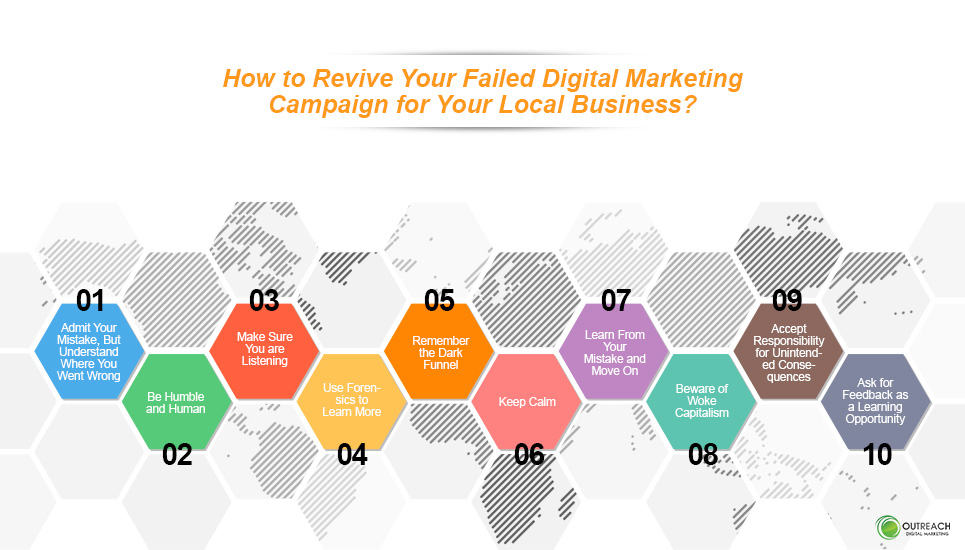If you find your digital marketing campaign causes unintentional consequences, it can be hard to recover with your dignity and company reputation intact. Today, the main challenge for businesses is trying to get people to take a certain action when they have become so unpredictable. So, while it might feel like you have it all figured out when you run your campaign, there are just too many factors that impact outcomes.
In fact, today, sensitivities are heightened, and a completely harmless marketing campaign could have an entire group up in arms overnight. Suddenly social media, not just in your own backyard but across the country, is raging, and you are scrambling to figure out why. This is something hard to come back from, especially for a small business.
The good news is there are ways to regain trust for your brand after a failed digital marketing campaign, even when the damage reaches unmanageable levels. Here we look at how you can pinpoint where you went wrong and create a strategy to reconcile with an angry audience.

Admit Your Mistake, But Understand Where You Went Wrong
Admitting your mistakes publicly is the best way to help remedy them. People go out of their way to tell you they are not impressed and expect a reaction to show you are sorry for offending them. Just keep in mind you can only admit your mistake when you know what it was. You have to research and fact-find to identify exactly how you offended so many people.
Because your mistake is unintentional, it can actually be even harder to recover. Your safest bet is to understand exactly why people are angry so you can avoid making matters worse. Only then can you expertly take control of the negative narrative. You have to:
- Determine who seems to be the most vocal about the campaign
- Review their feedback to look for the specifics of what has them up in arms
- Explore the connotations of what you said, so you understand what made it offensive
- Understand the pain points of the group(s) in question
- Ensure you are using politically correct, acceptable terms
Be Humble and Human
Making mistakes is part of being human. As mentioned above, you need to approach this from a place of knowledge so you can ensure you make the right apology and have a suitable solution. However, you also need to act fast and take responsibility from a position of humility to reestablish a connection with your audience. The best way to do this is to share a video apology showing your team. People will realize you’re not just a business but a person who can make mistakes. Be humble with a sincere apology, preferably not overly rehearsed or scripted. Let people know you appreciate them and have built your business through their trust. Let them know you will make every possible effort to rebuild that trust.
Make Sure You are Listening
Although it might seem people are completely overreacting, you need to listen to what they are saying. It can be easy to react to anger with anger and become defensive. However, when this happens, you shut down your ability to really hear the complaints and remember they come from a place of honesty and hurt. If your knee-jerk reaction is to defend yourself, this just makes matters worse.
The more you engage the group in negative conversation, the more legs you give the event to spread. Take note of every comment, and find ways to address concerns with empathy, understanding, and humanity. You might not agree with what people are saying, but you have to make it clear you do hear them and respect their right to voice their opinions.
Use Forensics to Learn More
Approach your resolution process using a “forensic analysis” to identify the course, reasons and potential factors contributing to the issue. You need to understand what went wrong. It could be you chose the wrong audience. It could be related to the wording used. It could be a complete misreading of the proverbial “room.” Only then can you come up with a resolution to remedy the issue and restore your campaign to something relatable and effective. It’s also the best way to ensure something like this never happens again.
Remember the Dark Funnel
We’ve all heard about the rabbit hole leading people further and further into a mess of online misinformation. In sales, there is the “dark funnel” where prospects search and review information not provided by your ideal resources. At this stage of the game, people are influenced by resources you don’t control or even see. People are already developing a mindset in the dark funnel that determines whether they react negatively or positively to your marketing tactics.
As mentioned above, people’s reactions are difficult to predict, and this is truer than ever because of the dark funnel. People share information with each other in private forums, something they’ve always done. However, what has changed is the reach of those forums. It is no longer about chats around the water cooler, parents at school, or friends and family. Today strangers interact in conversations with thousands of people, making it far harder to predict what will happen next.
However, intent data can help. It includes sources such as:
- Industry publications
- Blogs
- Social networks
- Influence outlets
- Product review sites
While you might not have access to information exchanged through word of mouth, these resources can be researched to better understand what drives people’s opinions and molds their information-seeking experiences.
Keep Calm
Again, you have to avoid that instinctive knee-jerk reaction, whether it is anger or a panicky feeling, you have to do something fast. You must find the perfect balance between the appropriate response and how long it takes to compose it. Act too fast, and you’re going into the situation unarmed without the right information. Act too slowly, and you miss your opportunity to correct your mistakes.
You need to take a minute to compose yourself, understand what has happened, and then create a respectful response. It’s all about reading the room and using the appropriate tone and manner to help reduce the amount of harm you cause.
Learn From Your Mistake and Move On
Whether your damage control is effective or not, you need to learn from your mistake and move on. Instead of trying to adapt an existing campaign that failed, start fresh. Take the opportunity to learn more about your audience and what they view as inappropriate, insensitive, or plain misinformed. Use your findings to take a better approach to help rebuild relationships and meet your digital marketing goals.
Review your new approach and look for possible risks before you release your campaign to the public. Then monitor reactions to look for opportunities to regain trust or where you could be at risk of further isolating your audience.
Beware of Woke Capitalism
We often miss the mark when we try to be something we’re not. People have caught on that even the most right-leaning companies are using left-wing beliefs and causes to appeal to a broader audience. It is exactly this kind of misstep that will generate negative reactions from truly woke consumers sick of corporations using their causes to further their bottom line.
You are much safer using data to drive your campaigns over trends you don’t understand. When you hop on the bandwagon of various causes, if it doesn’t come from a true place of understanding, authenticity, and genuine active support for these causes, be prepared to pay the consequences facing an angry audience.
Accept Responsibility for Unintended Consequences
The reaction your campaign spawned is the unintended consequence of your marketing campaign. You didn’t mean to open up that can of worms, but unfortunately, you did. If the unintended consequences include a viral and very public calling out of your brand, chances are you are not prepared for this scenario. Rely on your company’s core values to create a response that is authentic, trustworthy, and accepts responsibility for the consequences to help manage damage control.
Ask for Feedback as a Learning Opportunity
Because whatever happened was unintentional, you can appeal to people’s kinder side. Ask people to join you offline to further the conversation. A genuine desire to understand what happened helps you avoid further mistakes. Although many people might respond with anger or simply ignore your request, you could find a sincere apology and desire to learn could open the doors of honest conversation.

When a marketing campaign goes wrong, it creates a massive PR nightmare you’ll need to manage with kid gloves. However, it also provides an opportunity to understand your audience better. Through fact-finding exercises, honest evaluation, conversations, and a commitment to make things right, you can set yourself on the path to creating more appropriate, effective campaigns.
Having a team of professionals on your side will help avoid these mistakes. Hop on a free discovery call to see how we can help.
